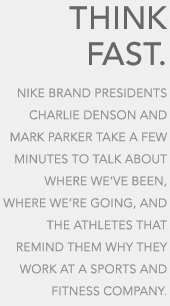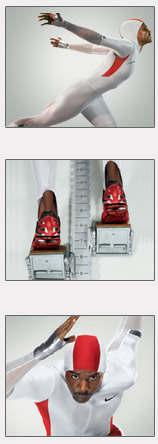
 |
Three years ago, you were asked to simplify Nike, Inc.; to manage the brand and put us on the road to operational excellence and align product, marketing, sales and retail. We're making great progress-but how do you simplify a business like Nike? Charlie Denson: We had to reenergize the corporate culture of competitiveness and focus. We had to clarify our growth agenda. Put simply, we need to focus on knowing who our consumer is, who we're competing against, and who we are. When we know those answers, we think we can win. The financial successes are the results of having a better consumer connection, having a clearer idea of who we are, having a clearer sense of how we're going to be more competitive in each of the different pieces of the business around the world. Mark Parker: You focus on the fundamentals: Organizational strength and common goals. Both Charlie and I fixated on making sure we were more competitive in each distinct piece of the business. It's a basic approach, but we both saw a huge opportunity to be more competitive by better executing the fundamentals while better connecting with those we're here to serve. Football. Soccer. March to March, our football footwear was #1 in Europe. What does our success in this global sport meanto the brand? MP: The fact that we set a 10-year goal and we've made consistent progress against it year to year has been among the most satisfying things we've done in this company. But the "There is no finish line" mantra is very much alive around here. It shows us that when we set goals, get the right team of people focused, create great product and connect with the best athletes and teams and then rally around those goals, we can achieve almost anything. CD: It's become a source of energy and inspiration for other categories and that's one of the big benefits of where we are right now in football. It's been a great benchmark to use as a success story. |
||
 |
|||
China has been booming for most businesses. What can you say about how we've been conducting business there for the last few years? And what about other emerging economies: Russia, Brazil, India? CD: We've brought all four of those businesses in as Nike-owned and all four will represent important pieces of our growth agenda over the next five years. We have a significant head start in China where we've seen exciting growth. China grew 66% in revenue in the past year. The velocity of the business in China could be overwhelming, but the team has done an unbelievable job. They're opening up one retail space a day. In South America, we're starting to work on a different model by doing more local sourcing that we'll test in Brazil. It will mitigate some of the geopolitical and financial risks of doing business in an emerging economy, which we may be able to use in India or Russia in the future. MP: We'll always be aggressive in new markets, but with a sensitivity to the culture and the consumer, as opposed to simply importing the brand and product to developing countries and newer markets. We need to make sure that what the brand stands for is clear and consistent but also relates to and respects the insights that we gain from that culture and those consumers. In the end, that makes Nike a stronger, more relevant and interesting brand�both locally and globally. How have we approached and evolved the women's business? CD: It's a complex challenge, but we're getting better at it, and I'm optimistic. The women's business is much more varied region to region than the men's business-the women's consumer in the US is much different from the women's consumer in Europe or Asia. But we've finally reached a point in this company's maturity and the evolution of the consumer and the changes in the marketplaces themselves that are enabling us to optimize this opportunity. MP: The women's business has always been a big opportunity for Nike, but what's put us in a better position is putting a strong team together, listening to and better connecting to consumers, and being clear and focused on what's really relevant in putting the brand and the product in a more compelling position with the consumer. It's been a year since we promised LeBron James more money than he could ever spend. Since then, Nike's spent big bucks on Freddy Adu and Serena Williams. How do you explain to a shareholder who's wondering whether we're spending responsibly that this is the right thing to do? CD: It's our history, and our history has served us well. It's what we do and it's how we do it. When you're with these types of individuals on an almost daily basis, it becomes a fairly easy call to say this athlete or this person is someone special. MP: LeBron James is one of those very special athletes who comes along with that rare level of talent and charisma that gives us the license to take the consumer somewhere totally new. So in a sense, that makes it a bargain. LeBron helps authenticate and legitimize new directions in product design to levels beyond most other athletes. |
|||
 |
|||
 |
Wish to address some highlights of the past year? MP: Two areas in particular: product and community affairs. Our new line of soccer products, such as the Air Zoom Total 90 III shoe, has helped put us in a market leadership position in soccer footwear in Europe. We've seen incredible advances with Nike Shox footwear in the last year with women's-specific performance product. In Apparel, Nike Sphere continues its quiet revolution in performance comfort. The product you'll see this year around our Speed initiative will really change the way athletes look at footwear, apparel and equipment and competitive advantage. We're also very proud of our work in community affairs. We give 3% of our pretax profit back to the communities where we live with a lot of our energy and investments focused on supporting physical activity for youth. CD: I agree with Mark-we're proud of our Community Affairs efforts. We're proud of the work NikeGo is doing to help reinstate physical education programs and turn recycled shoes into sports surfaces, just two of the many initiatives we drive to help Nike be a responsible part of the community. On the product side, we're excited about Nike Free, a footwear technology designed to mimic the bare foot. We've learned that training barefoot can strengthen the foot, the leg, the entire body. Basically, we've found that natural motion makes athletes stronger, and Nike Free is about the closest thing you can get to natural motion in a performance athletic shoe. And Nike iD-consumers can go online and customize product. It is the future, and we're just beginning to see its emergence. It will allow us to build an even more intimate relationship with consumers than we have today. We've always thought of ourselves as the brand that listens to athletes, and both Nike Free and Nike iD reflect that. Who are your favorite athletes? CD: It's impossible to have just one. One great thing about this job is that you have an opportunity to experience athletes in different phases of their careers. You can be energized by the youthfulness and optimism of a LeBron James, a Carmelo Anthony, a Serena Williams, a Freddy Adu- athletes who have their entire careers in front of them. The enthusiasm that oozes from them is fun to be around. Then you see people like Tiger Woods who are focused on being the greatest of all time or someone like Michael Jordan who's stepping into a continuation of that career from a business standpoint-you just can't pick a single person. That would be, in a sense, a disservice to the job. MP: This past year I've been more involved with my kids in sports, my son particularly. He got involved in cross country and track and was very successful in his first year. It was a reminder to me of the power of sports for kids and how important that is. To see my son get involved in a sport and a team, set goals and discipline himself to try to achieve those goals and to see him transform and gain confidence that helped him be a better student, interact with other kids at a higher level, and help make him an overall better person was inspiring. It's not all about the big global, megastar athletes-we've got to remind ourselves of the power of sports when it comes to kids and their development�and how inspiring that can be. Let's finish with Nike's biggest challenges as a brand and as a company. MP: We have so many opportunities in front of us that the degree of our success will be based on what choices we make and how we focus our energy and our investments against those decisions. And then making sure that we have the talent and the strength in the organization to build on what we've got and we'll execute against those new opportunities. CD: I find myself thinking more and more about the next phase. What will take Nike beyond our current growth strategy? What does a better, bigger Nike look and feel like? The one thing we have learned to count on is that the world of sports will continue to supply us with the stories, the personalities and the challenges to improve our product, our brand and our performance. |
||
| Click on the link below to view the complete 2004 annual report document as a PDF in Adobe� Acrobat� software. 2004 Annual Report (968K) |